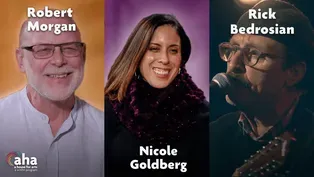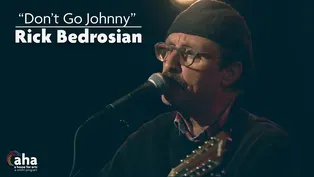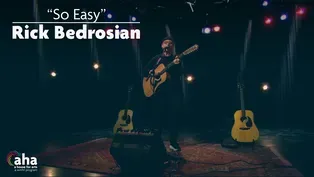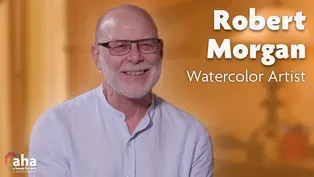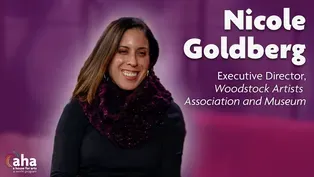
AHA! | 625
Season 6 Episode 25 | 26m 46sVideo has Closed Captions
Watercolor paintings, Woodstock Artists Association and Museum, and a performance.
Explore the watercolor paintings of Robert Morgan. Learn about the Woodstock Artists Association and Museum from Executive Director Nicole Goldberg. Rick Bedrosian performs "Don't Go Johnny" at WMHT Studios.
Problems with Closed Captions? Closed Captioning Feedback
Problems with Closed Captions? Closed Captioning Feedback
AHA! A House for Arts is a local public television program presented by WMHT
Support provided by M&T Bank, the Leo Cox Beach Philanthropic Foundation, and is also provided by contributors to the WMHT Venture Fund including Chet and Karen Opalka, Robert & Doris...

AHA! | 625
Season 6 Episode 25 | 26m 46sVideo has Closed Captions
Explore the watercolor paintings of Robert Morgan. Learn about the Woodstock Artists Association and Museum from Executive Director Nicole Goldberg. Rick Bedrosian performs "Don't Go Johnny" at WMHT Studios.
Problems with Closed Captions? Closed Captioning Feedback
How to Watch AHA! A House for Arts
AHA! A House for Arts is available to stream on pbs.org and the free PBS App, available on iPhone, Apple TV, Android TV, Android smartphones, Amazon Fire TV, Amazon Fire Tablet, Roku, Samsung Smart TV, and Vizio.
Providing Support for PBS.org
Learn Moreabout PBS online sponsorship(bright upbeat music) - [Lara] Explore the surreal watercolors of artist Robert Morgan, discuss community arts with the Executive Director of the Woodstock Artists Association and Museum, and enjoy performance by Rick Bedrosian.
It's all ahead on this episode of AHA, A House for Arts.
- [Announcer] Funding for AHA has been provided by your contribution and by contributions to the WMHT Venture Fund.
Contributors include Chet and Karen Opalka, Robert and Doris Fischer Malisardi, The Alexander & Marjorie Hover Foundation, and The Robison Family Foundation.
- At M&T Bank we understand that the vitality of our communities is crucial to our continued success.
That's why we take an active role in our community.
M&T Bank is pleased to support WMHT programming that highlights the arts, and we invite you to do the same.
(bright upbeat music) Hi, I'm Lara Ayad, and this is AHA, A House for Arts, a place for all things creative.
Let's send it over to Matt Rogowicz for today's field segment.
(soft guitar music) - I'm here in Petersburg, New York, to look at the watercolors of artist, Robert Morgan.
He tries to serve different emotions in the viewer by collaging unique elements together into one large piece.
Follow me.
(bright guitar music) - As you can see here, watercolor is the main medium undies but they're far from watercolors as such.
I try to stretch the medium with respect to size and density of pigment, and subject matter as well.
So there are anything but precious, which is usually attributed to watercolors.
Even as a youngster, I would paint from life or draw from life, and I would get totally lost in it.
I would forget where I am, I would be just focusing in on that.
And that pleasure has been consistent my whole life.
I grew up nearby in Pittsfield.
And as you know, the Hudson Valley/Berkshires Museums they're full of sergeants and homer watercolors and all this.
So that's what I was exposed to early on.
But I'm pushing that tradition that I grew up with to a different place, I think.
(bright instrumental music) I probably use watercolor different than most people.
Like I put paint from the tube into a cup, and mix it with water and make like a syrup.
Well, interesting enough, I'm colorblind.
So... (laughs softly) my use of color is, I have a very simple palette.
I use six or seven paints, and it's written on the tube so I know what color it is, (laughing loudly) but no, I'm not that bad.
I'm a typical red, green thing.
I don't see red in a field of green.
I still have softness in there where appropriate, but I'm going dark in a lot of places that most watercolors don't.
Watercolor paper doesn't come this big.
So I don't know if you notice, they're all collaged.
(soft ambient music) I do an image, I cut it out, I glue it together.
I'm sometimes doing five or six layers of watercolor paper glued together.
I want my work to resonates.
I guess like a cricket rubbing its back legs.
I wanna pair contrasts together to give that resonance, like hard and soft, cool and war, dangerous and peaceful.
I like to pair these things much like surrealists, I guess.
They sought to perhaps unleash the creative subconscious by juxtaposing disparate images together.
Well, I think I'm trying to do this same thing, only pushing it a little further.
I might do a picture of the mass pipe.
I paired it against an oversized carousel in France.
So what does that do?
That makes it be almost a heaven or some sort of city in the background, and that jarring of perception and disparate images is what I'm trying to spark in the viewer, that feeling of, "Oh, why is this?"
(soft guitar music) French cow on vacation in Italy So I've got this cow placed on a mountaintop near Portofino.
Belgian Cedar in a rock field.
Obviously it's impossible to saw this field because there are giant rocks in it.
Iguazú encircling Florence.
So I got the Ponte Vecchio at the base of that giant waterfall in Brazil.
An American swamp in a Dutch landscape.
So it's almost an intimate, typical Dutch landscape with a giant tree from American swamp juxtaposed to it and a Volkswagen van thrown in to add a little mystery.
It is tongue in cheek, some of it.
Some of the images are so cliche that you would think that, "Wow, this is goofy, it's stupid."
But I'm doing that on purpose.
So some of it is on purpose humorous, some of it is dangerous.
There's a little danger lurking in all of these paintings, I think.
And that combination of humor and danger is powerful for me.
A lot of art is a one-liner, I think that's lazy.
I want people to come away being moved emotionally in some way.
Otherwise art is boring.
I don't wanna be boring.
That's the one thing I don't want here doing my art.
I want people to come away feeling something.
(bright instrumental music) - Nicole Goldberg has served at various non-profit arts institutions throughout her career, having worked as Director of Development at Art Omi in Columbia County and Director of Development at the Drawing Center in Soho.
Nicole joins me in studio to discuss the role of the museum in local communities, and her current role as the Executive Director of the Woodstock Artists Association and Museum.
Nicole, welcome to A House for Arts.
It's a pleasure to have you.
- Thank you for having me, I'm very happy to be here.
- So as Executive Director of the WAAM, which is the Woodstock Artists Association and Museum, tell us a little bit about the overall goals of the institution and what might people expect to see there if they were to walk in today?
- Sure.
So the WAAM is a 100-year-old museum.
It began in 1919 by several painters who had been living in the colony of Woodstock for a while, and decided after many years of living and working there, it was time to build a space, a permanent home to display their work, as well as the work of their peers who were living up in the region as well.
So they created the WAA, the Woodstock Artist Association.
Over time, those artists, along with their peers created this amazing community up there in Woodstock, in the village.
- And they called it an artist colony, right?
- It's called an artist colony, really began in 1902 with Byrdcliffe, the real artist colony, which was created very close to where the WAAM exists right now for artists to live and work and really create this community for artists.
Not unlike what was happening on the other side of the river the Hudson River, the Catskill Mountains were an inspiration for artists to create landscape paintings.
So artists who'd been living in this farming village came in and started doing landscape paintings of the rural landscape on our side of the Catskills.
So in 1919, they created this home for their work, and over the course of the century, the community grew.
And what you see now is really an amazing institution that has a permanent collection, which was actually begun in 1973, a permanent collection of 20th century American art, which is really an amazing microcosm of American art in our country.
You see the trajectory of art history starting from, the Hudson River School and obviously landscape paintings, and realism, all the way through the linear narrative so to speak of modern art that happened in the country and of course, throughout the world.
But you see the same thing happening in Woodstock.
So the post-impressionism and fauvism and surrealism- - Right, abstract expressionism?
- Abstract expressionism, more certainly in the 1950s.
- Is that what visitors would see if they were to walk in today?
These kinds of things?
- Yes.
The way the museum is structured right now, we have five galleries.
The gallery in the back was built in 1992, I believe, it's called the Tobin Wing.
And that is where we display our permanent collection.
So we have 2,000 objects representing mostly the 20th century American art.
And we do rotating exhibitions in that space based on the permanent collection.
So that's really where the historical material takes place.
In the other galleries, we do rotating contemporary exhibitions.
We also have youth exhibition space run by our education director.
And there are galleries on the lower level, again, where we display contemporary work.
The museum is called the Woodstock Artists Association, because when it was built in 1919, the idea was to really have this core community of member artists, which still exists today.
- Well, I'm just curious to know, Nicole.
Because it's making me think about the larger role of museums in smaller towns and rural areas versus cities.
And I know you've done work at Art Omi, which is in Columbia County, New York, which is, it's a large sculpture park, it's in a rural area, but you've also done a lot of work at the Drawing School in Soho and at MoMA in New York City.
Thinking big picture about this, so what you're telling me about the WAAM, what are the major roles of museums in smaller rural areas versus big cities?
Are they different at all?
- Well, I think there are two purposes that I can think of right now.
One is the idea of community building.
So the WAAM is, like I said, an artist association, one of the oldest artists associations in the country.
And what that means is we maintain a roster of nearly 400 member artists each year, who pay a very modest membership fee in order to participate in our exhibitions.
So we have a number of member and non-member exhibitions happening at all times.
And the membership base really becomes the heart and soul of the organization.
- Okay.
- And the way the WAAM works, our mission is really to promote and exhibit the work of local artists, regional artists.
So most of our exhibitions are featuring artists within a 50 mile radius.
So in that respect, it's about community building and making the members of the organization feel like they're part of a family so to speak.
- Right, it's like the local community is the lifeblood of the museum in a smaller rural area.
- [Nicole] Right.
- Whereas with a big city museum, if you will, kind of work colloquial way to refer to it.
Does it have a more of a national or international focus?
Is that where the distinction lies?
- The WAAM is located in the center of the town of Woodstock.
So we consider it a hub, right?
A smaller museum like that, its purpose's not only is to serve the local artists and community with excellent programming, but it's also to boost the cultural tourism in the area.
So the WAAM, of course isn't the only museum in town or the only art space in town, there's several more.
There's Byrdcliffe, which is our neighbor, the Center of Photography, the Woodstock Historical Society, and the Woodstock School of Art.
And together these organizations are a cultural alliance.
And one of the goals is really to bring tourists or bring daytrippers from the city or from this tri-state area to come to the town and really experience- - Got it.
- ...the art, the community.
And people think of Woodstock and they think of that 1969 Music Festival, which really didn't even happen in the town of Woodstock.
And the town has so much more to offer.
I think the role of the museum is really to be this cultural attraction.
- Right, and I'm kinda wondering too, because now that we're all having to be online and we've got physical distancing, what kinds of programs and virtual events does the WAAM have going on right now?
I think you had like a live performance of one of John Cage's musical pieces before, and discussion panels about art and healing.
- Yes.
- Can you tell us a little bit about that?
- Sure.
So obviously, every museum, every cultural organization had to pivot during the pandemic and bring as much programming online as possible.
So the WAAM did that.
Yes, we had a public program showing John Cage's performance.
It was done by Marco Benevento, who's a well-known musician in the area, and this art and healing panel discussion or group discussion.
I think right now museums are doing all they can to make the best of the technology and to make its audience, its visitors, still feel engaged with the material.
And I think that will exist beyond the pandemic itself.
I think there's many people are realizing, "Oh, I don't have to leave my house to see good art, "or to experience a panel discussion," which for some people is good.
And not only that, perhaps people who live remotely far away who don't have the opportunity to come to New York, whether it's New York City or upstate New York, they can still experience our programmings through an online portal, which is a new offering.
- So what you're telling us, Nicole, is that even with the challenges that you're dealing with today, the innovative ways that the WAAM has learned to address them may actually give you tools for moving forward way past the pandemic, way past the vaccinations to something that's really engaging and kinda pulls the community back in.
- Yeah, I think so.
- Well, thank you so much for being on A House for Arts.
It was such a pleasure speaking with you, Nicole.
- Thank you very much.
- Please welcome Rick Petrosian.
- Hi, I'm Rick Petrosian.
This is a song that I wrote based on conversation songwriters.
I remember meeting John Prine and getting to know him a little bit when I lived in Nashville, 'cause I played bass in a Marshall Chapman's band.
He was a fan of hers and I was the bass player in the band, so I had access to him a little bit.
And he always used to carry a little notebook and a pen with him, and I'd look over at him and I'd see him writing stuff down, and obviously, the great songwriters and the not-so-great songwriters, that's what you do.
If you hear something, you write it down.
So I remembered a friend of mine always saying, "Go 90," which she meant like live life fast and to the fullest.
And also another guy that I was in a band with told me that his father... we were talking about smoking cigarettes.
I smoked cigarettes for quite a while.
And he was talking about his father was hooked so bad that he smoked cigarettes in the shower.
And I always remembered that.
And I thought that would be nice in a song somehow.
Not a song about smoking, but anyway.
This is a song from my CD.
The CD is called "Inside My Car", and this one's called "So Easy".
(bright guitar music) ♪ Do you think it's funny ♪ ♪ I don't want your money but I like your teasing ♪ ♪ 90 miles an hour ♪ ♪ Smoking in the shower, tell me what's the reason ♪ ♪ People come and go so fast ♪ ♪ Nothing ever seems to last ♪ ♪ It's so easy baby, so easy tonight ♪ ♪ Relationships get strained ♪ ♪ People's feelings change ♪ ♪ And hearts are fragile ♪ ♪ Speeding down the highway ♪ ♪ Everything is okay, do you see an arrow ♪ ♪ Tell me what it's gonna be ♪ ♪ Do you wanna dance with me ♪ ♪ It's so easy, baby, so easy tonight ♪ ♪ The same dream haunts me every time I'm sleeping ♪ ♪ There are some dark secret that you're keeping ♪ ♪ Should we be together or should I say good bye and go away ♪ (bright guitar music) ♪ Tell me what's gonna be ♪ ♪ Do you on wanna dance with me ♪ ♪ It's so easy, baby, so easy tonight ♪ ♪ The same dream haunts me every time I'm sleeping ♪ ♪ There's some dark secret that you're keeping ♪ ♪ Should we be together or should I say goodbye and go away ♪ ♪ Do you think it's funny ♪ ♪ I don't want your money but I like your teasing ♪ ♪ 90 miles an hour ♪ ♪ Smoking in the shower, tell me what's the reason ♪ ♪ People come and go so fast ♪ ♪ Nothing ever seems to last ♪ ♪ It's so easy, baby, so easy tonight ♪ ♪ It's so easy, baby, so easy tonight ♪ ♪ So easy tonight ♪ ♪ So easy tonight ♪ (bright guitar music) So easy.
Thank you.
Here's a song I wrote about a guy named Johnny Reb.
He's a rockabilly cat.
He's like an Elvis Presley type guy, and he travels a lot.
When I was in his band, whenever he would travel, everybody, we didn't want him to go away because we wouldn't have any gigs.
So I wrote a song about Johnny Reb going away and I thought I'd kinda make it like based on "Go Johnny, go, Chuck Berry, Johnny, be good," I thought saying, "Don't go, Johnny," would be clever.
Apparently I was the only one that thought so but here's the song anyway, "Don't Go Johnny".
(bright guitar music) ♪ He writes song after the other cats have gone ♪ ♪ He looks like Elvis but his hair is long ♪ ♪ Girls date Johnny when he sings his songs ♪ ♪ Gets up at noon, some coffee and a pill ♪ ♪ Plays all night for a $50 bill ♪ ♪ Drink and dance and never get your fail ♪ ♪ Don't go ♪ ♪ Don't go, Johnny ♪ ♪ Don't go ♪ ♪ Don't go, Johnny ♪ ♪ Don't go ♪ ♪ Don't go, Johnny ♪ ♪ Don't go ♪ ♪ Don't go ♪ ♪ Stay, play, sing, you're the King ♪ ♪ Well, Johnny stays for six months then he splits ♪ ♪ While he's gone, his drummers fix their kids ♪ ♪ Johnny's waxing, skis in same Moritz ♪ ♪ Christmas in July 'cause Johnny's thrill ♪ ♪ Ice cold beer and burgers on the grill ♪ ♪ But we can't keep him here against his will ♪ ♪ Don't go ♪ ♪ Don't go, Johnny ♪ ♪ Don't go ♪ ♪ Don't go, Johnny ♪ ♪ Don't go ♪ ♪ Don't go, Johnny ♪ ♪ Don't go ♪ ♪ Don't go ♪ ♪ Stay, play, sing, you're the King ♪ (fast-paced guitar music) (bright guitar music) Eddie Angel.
(bright guitar music) ♪ Well, kings don't only rule, they sometimes dream, yeah ♪ ♪ Johnny filled his tank with gasoline ♪ ♪ He and Missy, what a crazy scene ♪ ♪ Don't go ♪ ♪ Don't go Johnny ♪ ♪ Don't go ♪ ♪ Don't go Johnny ♪ ♪ Don't go ♪ ♪ Don't go Johnny ♪ ♪ Don't go ♪ ♪ Don't go ♪ ♪ Stay, play, sing, you're the King ♪ ♪ Don't go ♪ ♪ Don't go Johnny ♪ ♪ Don't go ♪ ♪ Don't go Johnny ♪ ♪ Don't go ♪ ♪ Don't go Johnny ♪ ♪ Don't go ♪ ♪ Don't go ♪ ♪ Stay, play, sing, you're the King ♪ (fast-paced guitar music) Don't go, Johnny, stay right here.
(bright upbeat music) - Three.
Thanks for joining us.
For more arts, visit wmht.org/aha.
And be sure to connect with WMHT on social.
I'm Lara Ayad, thanks for watching.
(soft upbeat music) (soft ambient music) - [Announcer] Funding for AHA has been provided by your contribution and by contributions to the WMHT Venture Fund.
Contributors include Chet and Karen Opalka, Robert and Doris Fischer Malisardi, The Alexander & Marjorie Hover Foundation, and The Robison Family Foundation.
- At M&T Bank we understand that the vitality of our communities is crucial to our continued success.
That's why we take an active role in our community.
M&T Bank is pleased to support WMHT programming that highlights the arts, and we invite you to do the same.
Video has Closed Captions
Preview: S6 Ep25 | 30s | Watercolor paintings, Woodstock Artists Association and Museum, and a performance. (30s)
AHA! | 625: Rick Bedrosian "Don't Go Johnny"
Video has Closed Captions
Clip: S6 Ep25 | 3m 54s | Rick Bedrosian performs "Don't Go Johnny" on AHA! A House for Arts. (3m 54s)
AHA! | 625: Rick Bedrosian "So Easy"
Video has Closed Captions
Clip: S6 Ep25 | 4m 28s | Rick Bedrosian performs "So Easy" on AHA! A House for Arts. (4m 28s)
AHA! 625 | Watercolor Artist Robert Morgan
Video has Closed Captions
Clip: S6 Ep25 | 5m 42s | Artist Robert Morgan strives to push the envelope when it comes to watercolors. (5m 42s)
AHA! 625 | Woodstock Artists Association and Museum
Video has Closed Captions
Clip: S6 Ep25 | 9m 31s | Don't miss Nicole Goldberg's interview with Lara Ayad. (9m 31s)
Providing Support for PBS.org
Learn Moreabout PBS online sponsorshipSupport for PBS provided by:
AHA! A House for Arts is a local public television program presented by WMHT
Support provided by M&T Bank, the Leo Cox Beach Philanthropic Foundation, and is also provided by contributors to the WMHT Venture Fund including Chet and Karen Opalka, Robert & Doris...
